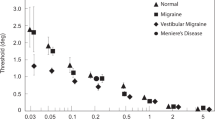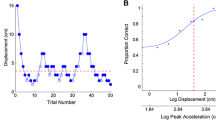Abstract
Background
Vestibular migraine (VM) is a relatively recently acknowledged vestibular syndrome with a very relevant prevalence of about 10% among patients complaining of vertigo. The diagnostic criteria for VM have been recently published by the Bárány Society, and they are now included in the latest version of the International Classification of Headache Disorders, yet there is no instrumental test that supports the diagnosis of VM.
Objective
In the hypothesis that the integration of different vestibular stimuli is functionally impaired in VM, we tested whether the combination of abrupt vestibular stimuli and full-field, moving visual stimuli would challenge vestibular migraine patients more than controls and other non-vestibular migraineurs.
Methods
In three clinical centers, we compared the performance in the functional head impulse test (fHIT) without and with an optokinetic stimulus rotating in the frontal plane in a group of 44 controls (Ctrl), a group of 42 patients with migraine (not vestibular migraine, MnoV), a group of 39 patients with vestibular migraine (VM) and a group of 15 patients with vestibular neuritis (VN).
Results
The optokinetic stimulation reduced the percentage of correct answers (%CA) in all groups, and in about 33% of the patients with migraine, in as many as 87% of VM patients and 60% of VN patients, this reduction was larger than expected from controls’ data.
Conclusions
The comparison of the fHIT results without and with optokinetic stimulation unveils a functional vestibular impairment in VM that is not as large as the one detectable in VN, and that, in contrast with all the other patient groups, mainly impairs the capability to integrate different vestibular stimuli.



Similar content being viewed by others
References
Dieterich M, Brandt T (1999) Episodic vertigo related to migraine (90 cases): vestibular migraine? J Neurol 246:883–892
Strupp M, Versino M, Brandt T (2010) Vestibular migraine. In: Handbook of clinical neurology, vol 97, pp 755–771
Cass SP, Ankerstjerne JKP, Yetiser S et al (1997) Migraine-related vestibulopathy. Ann Otol Rhinol Laryngol 106(3):182–189
Versino M, Sances G, Anghileri E et al (2003) Dizziness and migraine: a causal relationship? Funct Neurol 18:97–101
Brandt T, Strupp M (2006) Migraine and vertigo: classification, clinical features and special treatment considerations. Headache Curr 3(1):12–19
Waterston J (2004) Chronic migrainous vertigo. J Clin Neurosci 11(4):384–388
Neuhauser H, Leopold M, von Brevern M et al (2001) The interrelations of migraine, vertigo, and migrainous vertigo. Neurology 56:436–441
Neuhauser H, Lempert T (2004) Vertigo and Dizziness Related to Migraine: a Diagnostic Challenge. Cephalalgia 24:83–91
Neuhauser HK, Radtke A, von Brevern M et al (2006) Migrainous vertigo: prevalence and impact on quality of life. Neurology 67:1028–1033
Lempert T, Neuhauser H (2009) Epidemiology of vertigo, migraine and vestibular migraine. J Neurol 256:333–338
Kayan A, Hood JD (1984) Neuro-otological manifestations of migraine. Brain 107(Pt 4):1123–1142
Kuritzky A, Ziegler DK, Hassanein R (1981) Vertigo, motion sickness and migraine. Headache J Head Face Pain 21(5):227–231
Lempert T, Olesen J, Furman J et al (2012) Vestibular migraine: diagnostic criteria. J Vestib Res 22:167–172
Headache Classification Committee of the International Headache Society (IHS) (2018) The international classification of headache disorders, 3rd edition. Cephalalgia 38(1):1–211
von Brevern M, Lempert T (2016) Vestibular migraine. In: Handbook of clinical neurology, vol 137, pp 301–316
von Brevern M, Zeise D, Neuhauser H et al (2005) Acute migrainous vertigo: clinical and oculographic findings. Brain 128:365–374
Radtke A, von Brevern M, Neuhauser H et al (2012) Vestibular migraine: long-term follow-up of clinical symptoms and vestibulo-cochlear findings. Neurology 79:1607–1614
Bir LS, Ardiç FN, Kara CO et al (2003) Migraine patients with or without vertigo: comparison of clinical and electronystagmographic findings. J Otolaryngol 32:234–238
Boldingh MI, Ljøstad U, Mygland Å, Monstad P (2013) Comparison of interictal vestibular function in vestibular migraine vs migraine without vertigo. Headache 53:1123–1133
Casani AP, Sellari-Franceschini S, Napolitano A et al (2009) Otoneurologic dysfunctions in migraine patients with or without vertigo. Otol Neurotol 30:961–967
Harno H, Hirvonen T, Kaunisto MA et al (2003) Subclinical vestibulocerebellar dysfunction in migraine with and without aura. Neurology 61:1748–1752
Jeong S-H, Oh S-Y, Kim H-J et al (2010) Vestibular dysfunction in migraine: effects of associated vertigo and motion sickness. J Neurol 257:905–912
Versino M, Colagiorgio P, Sacco S et al (2014) Reading while moving: the functional assessment of VOR. J Vestib Res 24(5–6):459–464
Colagiorgio P, Colnaghi S, Versino M, Ramat S (2013) A new tool for investigating the functional testing of the VOR. Front Neurol 4:165
Ramat S, Colnaghi S, Boehler A et al (2012) A device for the functional evaluation of the VOR in clinical settings. Front Neurol 3:39
Corallo G, Versino M, Mandalà M et al (2018) The functional head impulse test: preliminary data. J Neurol 265(Suppl 1):35–39
Doreen TV, Lucieer F, Duijin S et al (2019) The functional head impulse test to assess oscillopsia in bilateral vestibulopathy. Front Neurol 10:365
Sjögren J, Fransson PA, Karlberg M et al (2018) Functional head impulse testing might be useful for assessing vestibular compensation after unilateral vestibular loss. Front Neurol 9:979
Watson AB, Pelli DG (1983) Quest: a Bayesian adaptive psychometric method. Percept Psychophys 33:113–120
Colnaghi S, Rezzani C, Gnesi M et al (2017) Validation of the Italian Version of the dizziness handicap inventory, the situational vertigo questionnaire, and the activity-specific balance confidence scale for peripheral and central vestibular symptoms. Front Neurol 8:528
Wang J, Lewis RF (2016) Contribution of intravestibular sensory conflict to motion sickness and dizziness in migraine disorders. J Neurophysiol 116(4):1586–1591
Lim Y-H, Kim J-S, Lee H-W, Kim S-H (2018) Postural instability induced by visual motion stimuli in patients with vestibular migraine. Front Neurol 9:433
Cullen KE (2019) Vestibular processing during natural self-motion: implications for perception and action. Nat Rev Neurosci 20(6):346–363
Brandt T, Dieterich M (2019) Thalamocortical network: a core structure for integrative multimodal vestibular functions. Curr Opin Neurol 32:154–164
De Tommaso M, Ambrosini A, Brighina F et al (2014) Altered processing of sensory stimuli in patients with migraine. Nat Rev Neurol. 10:144–155
Espinosa-Sanchez JM, Lopez-Escamez JA (2015) New insights into pathophysiology of vestibular migraine. Front Neurol. 6:12
Shin JH, Kim YK, Kim HJ, Kim JS (2014) Altered brain metabolism in vestibular migraine: comparison of interictal and ictal findings. Cephalalgia 34(1):58–67
Brandt T, Bartenstein P, Janek A, Dieterich M (1998) Reciprocal inhibitory visual-vestibular interaction. Visual motion stimulation deactivates the parieto-insular vestibular cortex. Brain 121(Pt 9):1749–1758
Messina R, Rocca MA, Colombo B et al (2017) Structural brain abnormalities in patients with vestibular migraine. J Neurol 264(2):295–303
Obermann M, Wurthmann S, Steinberg BS et al (2014) Central vestibular system modulation in vestibular migraine. Cephalalgia 34:1053–1061
Bense S, Stephan T, Yousry TA et al (2001) Multisensory cortical signal increases and decreases during vestibular galvanic stimulation (fMRI). J Neurophysiol 85(2):886–899
Deutschländer A, Bense S, Stephan T et al (2002) Sensory system interactions during simultaneous vestibular and visual stimulation in PET. Hum Brain Mapp 16(2):92–103
Dieterich M, Bense S, Stephan T et al (2003) FMRI signal increases and decreases in cortical areas during small-field optokinetic stimulation and central fixation. Exp Brain Res 148(1):117–127
Bense S, Bartenstein P, Lochmann M et al (2004) Metabolic changes in vestibular and visual cortices in acute vestibular neuritis. Ann Neurol 56:624–630
Bense S, Stephan T, Bartenstein P et al (2005) Fixation suppression of optokinetic nystagmus modulates cortical visual-vestibular interaction. NeuroReport 16:887–890
Author information
Authors and Affiliations
Corresponding author
Ethics declarations
Conflicts of interest
Stefano Ramat is a shareholder of Beon Solutions srl (Zero Branco, TV, Italy), a company producing the fHIT system used in this study.
Ethical standards
All the procedures performed were in accordance both with clinical and with the ethical and privacy standards of the institutional ethical committees and with the 1964 Helsinki declaration.
Informed consent
The participants signed an informed consent form.
Electronic supplementary material
Below is the link to the electronic supplementary material.
Rights and permissions
About this article
Cite this article
Versino, M., Mandalà, M., Colnaghi, S. et al. The integration of multisensory motion stimuli is impaired in vestibular migraine patients. J Neurol 267, 2842–2850 (2020). https://doi.org/10.1007/s00415-020-09905-1
Received:
Revised:
Accepted:
Published:
Issue Date:
DOI: https://doi.org/10.1007/s00415-020-09905-1




